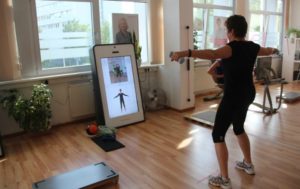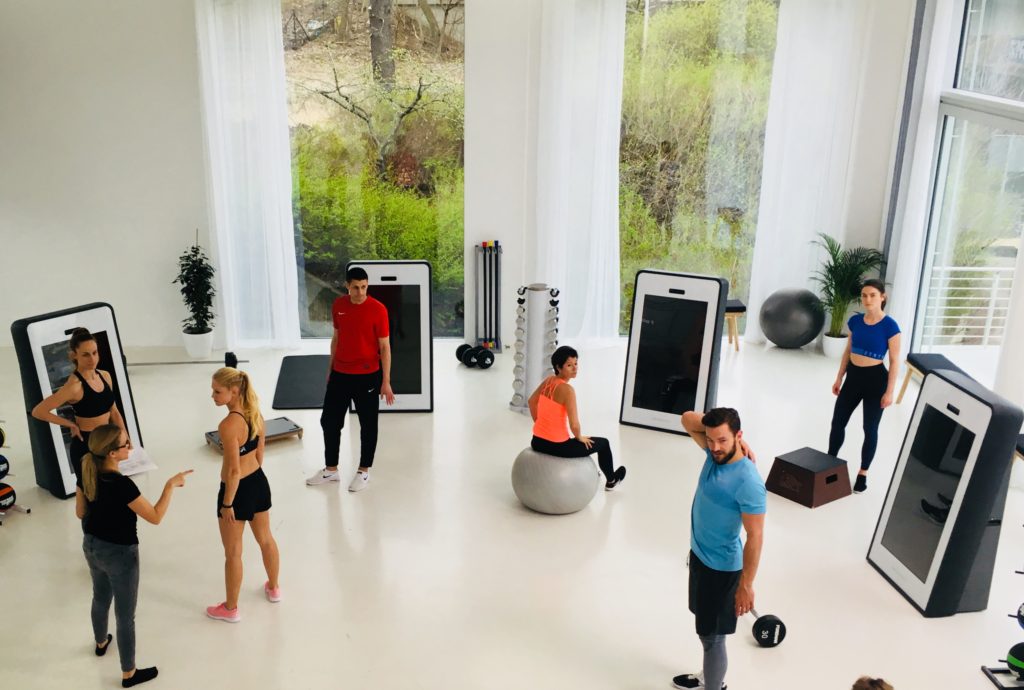 Pixformance gave me an incredible opportunity marry my interest in AR-tech with my passion for movement and fitness. I had spent the last 6 years playing around in circus arts (chinese pole, acrobatics, aerial silks, hoop and rope), a little trick riding/vaulting and a little martial arts. Yep, Jeet Kune Do, because there’s something humbling about sparring with a bunch of teenage boys in a warehouse as a grown woman.
Pixformance gave me an incredible opportunity marry my interest in AR-tech with my passion for movement and fitness. I had spent the last 6 years playing around in circus arts (chinese pole, acrobatics, aerial silks, hoop and rope), a little trick riding/vaulting and a little martial arts. Yep, Jeet Kune Do, because there’s something humbling about sparring with a bunch of teenage boys in a warehouse as a grown woman.
I had recently gotten my yoga teacher certification to pass my time chasing Badradish. My research and work as Product Manager at Pixformance came from a freely passionate place and I very much enjoyed doing it.
Some takeaways from my first tech position at a young company included:
- The importance of focus with limited resources,
- When building an MVP of an existing product, it is conceptually more difficult to remove features than add them
- Having passion and doesn’t always mean your ideas align with business goals and direction

In this intriguing experience, I confronted something that didn’t quite satisfy a tenet I learned at Microsoft Surface – porting a posteriori experiences (e.g. mouse and keyboard or mobile device workflows) to a new device-type doesn’t always work to bring out the potential value of said new experience. It takes a different kind of design effort to rethink the experience end-to-end. You can’t copy-paste experiences to new devices, no matter how tempting it is to do so.
The Smart Trainer leveraged whole body-tracking capability incredibly well, a key differentiator of the device which enabled initial adoption at many Mrs. Sporty gyms. When I started working on the product, I noticed it followed more or less a “traditional” fitness app model, which made sense at the time. I researched heavily to figure out how to change that.
Here a just a few of the things I discovered when working on the Smart Trainer MVP with my colleagues:
- Fitness apps and trackers struggle with tragic abandonment rates, not similar to gym abandonment rates. Have you ever signed up for the gym with gusto after New Year’s and find yourself trying to get out of the membership by July? While wearables can “retain” you a bit longer (because they’re always with you), they’re still left behind. From the vantage point of fitness and self-improvement, it’s critical to ask “why?”
- I suspected that fitness apps at the time still hadn’t figured out how to address less obvious issues behind human motivation. They didn’t help the user set goals in a way that fits their lifestyle and needs. In the past, apps focused on numbers and counting (because the tech enables that), but creators hadn’t yet gotten to the meat of the issue with health improvement – motivating people to change their habits and lifestyle. Change requires rethinking things like self-limiting beliefs and identifying intrinsic motivators. That’s hard work that usually involves a good therapist or coach.
- Some successful apps have circumvented this by offering user an “identity” or entry into /extension of a group identity. A+ for the apps that got that! Freeletics for the Crossfit people and Asana Rebel for yogis (guess which one I’m into?).
- Stats, numbers, reports and badges effectively motivate, at first. After some time, they invariably get boring, or even worse, stressful. This is true in games as well. Exercise and play should never get to that point. The last thing anyone wants in their life is another hamster wheel to run on.
One solution to some of the above points means building an evolving experience that helps the user become aware of themselves; goals set without awareness of personal intention are rarely effective long-term:
“To be achieved a goal needs to become real to the client. As one US coach explained, ‘The more it matters to the client, the more it acts as a magnet: it will draw in the person rather than the person having to push for it.’ In fact for her this was the most critical issue in the process. Only those goals that have personal relevance and meaning are ones that are likely to be achieved and bring fulfillment in the longer term.”
Dr. Sabine Dembkowski and Fiona Eldridge: Beyond GROW: A new coaching model. International journal of mentoring or coaching
Following intention setting, a good coach or fitness app would assist their client/user in creating their own scaffolding to support themselves while developing self and body awareness, independent of numbers, reports or analytics. This doesn’t mean that the latter shouldn’t exist – they need to – but I believe it’s critical to look beyond the numbers.
“You will begin to touch heaven, Jonathan, in the moment that you touch perfect speed. And that isn’t flying a thousand miles an hour, or a million, or flying at the speed of light. Because any number is a limit, and perfection doesn’t have limits. Perfect speed, my son, is being there.”
Richard Bach, Jonathan Livingston Seagull
I long to help people “fall” into themselves during a workout, not reach out of themselves, which is inherently difficult to do with an external device-aid. From my own training experiences, I felt the most motivated after achieving a deep flow state and losing myself. I started to achieve this much more easily after my yoga training. Interestingly, this had everything to do with mental wiring and meditation practice, not physical movements. I had practiced yoga for 10 years prior and didn’t “get” it until I learned how to approach it differently.
Nikolai Bernstein, Ido Portal, Tom Weksler, and Bruce Lee top my list of inspirations. They view athleticism as more than just drilling superficial movements. They keenly understand the role of mind in physical training. Given this vantage point, fitness devices and apps continue to neglect body awareness and I would like to see this change someday.